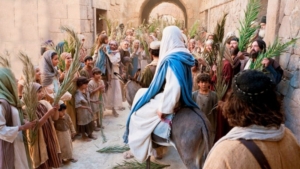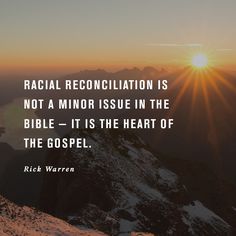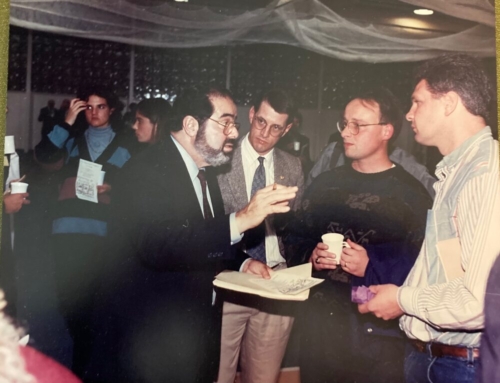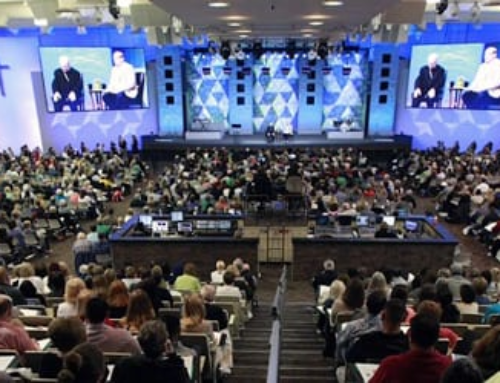Hosanna!!
 With racial issues dominating our news as of late, I thought this would be a good time to explore what the Bible has to say about the subject. Actually, the Bible has a lot to say about race. Three main theological threads appear interwoven throughout scripture — one of those threads is racial reconciliation.
With racial issues dominating our news as of late, I thought this would be a good time to explore what the Bible has to say about the subject. Actually, the Bible has a lot to say about race. Three main theological threads appear interwoven throughout scripture — one of those threads is racial reconciliation.
The first of these theological threads emerges from the fall of Adam in the Garden in Eden. From that point on, the story arc of the Scripture is about God’s effort to reconcile Man with Himself. The second thread appears shortly thereafter, in the story of Cane killing his brother Abel. From that point forward, the Bible also becomes a story of man learning to love his neighbor. These two story arcs are summed up in the Great Commandments: to love God and to love your neighbor.
The third story arc is not nearly as obvious, so it is often overlooked. It is a theme that starts out slowly in Scripture, yet comes into full view in the New Testament, especially in the writings of Paul. This third thread first appears at the Tower of Babel. It is at the Tower of Babel that humanity is first divided into groups according to language. As soon as man was divided into groups, tribalism (or in-group bias) became a major issue in the story of Man. From that point on, history became a story of “Us versus Them.” Nations began wars against nations. They began to continually oppress and enslave one another.
The story of tribal reconciliation rose into prominence in Isaiah 2:4: “and they [the nations] shall beat their swords into plowshares, and their spears into pruning hooks; nation shall not lift up sword against nation, neither shall they learn war anymore.” It can be seen that this is an important idea in Old Testament theology, from the fact this prophesy is repeated word-for-word in Micah 4:3 (see also: Psalms 46:9, Zechariah 9:10).
Tribal reconciliation, however, really comes to the forefront in the New Testament. Jesus’ parable of “The Good Samaritan” is embedded in the historical, racial animus between Jew and Samaritan (Luke 11:25-37). Much of Jesus’ teaching towards loving your enemy was directed towards Jewish feelings about their Roman rulers. A major theme repeated throughout Paul’s ministry is helping Christian Jews and gentiles to live in harmony, and to love and respect one another. Let’s examine racial reconciliation through the lens of the life-and-times of Jesus.
As you may know, Jesus was not the type of Messiah the Jewish people had expected. In 30 A.D. the Jews were looking for a military Messiah who would deliver them from Roman rule. What did it mean to desire a military Messiah?
 The Jews were not looking for a peaceful change of government. The Jews hated the Romans with a fiery passion and wanted the Romans out of their country, by any means necessary. What they desired was not something like the “Reagan Revolution” that happened in the voting booth. No, the Jews wanted a violent revolution that would be fought in the streets and pastures. They were looking for a Messiah to lead them into battle
The Jews were not looking for a peaceful change of government. The Jews hated the Romans with a fiery passion and wanted the Romans out of their country, by any means necessary. What they desired was not something like the “Reagan Revolution” that happened in the voting booth. No, the Jews wanted a violent revolution that would be fought in the streets and pastures. They were looking for a Messiah to lead them into battle
THE GREAT JEWISH REVOLT AGAINST ROME AD: 66-73
We catch a glimpse of this in the familiar story of the first Palm Sunday. As Jesus enters Jerusalem, sitting on a foal of a donkey, and people are spreading the cloaks and branches in his path while yelling, “Blessed is the coming kingdom . . . Hosanna!” (Mark 11:9; cf. Matthew 21:9); “Blessed is the King who comes in the name of the Lord” (Luke 19:38); “Hosanna! Blessed is he who comes in the name of the Lord, even the King of Israel!” (John 12:13).
The Biblical story of Palm Sunday is an example of the Biblical authors’ use of irony. The Gospel writers saw the actions of the Jews on Palm Sunday as true in a way that the Jews never anticipated: Jesus would reign in a spiritual kingdom. When we read the story today, we catch the meaning the authors placed on these events, while missing the original intent of the raucous Jewish crowd.
Today, we view the Jewish word “Hosanna” as being roughly equivalent to the Hebrew word “Hallelujah,” meaning, “Praise the Lord.” The Hebrew word yasha means “to save” and anna means “I beseech,” or “I pray.” The word Hosanna is actually a plea for help: “save now!” or “save us, we pray!” We see Hosanna used this way in Psalms 118:25: “Save us, we pray, O LORD!” That the Jews utter joyous shouts of “Hosanna” indicates they anticipate an imminent deliverance from their Roman enemy.
When we read these words in our churches, we inevitably think about Jesus’ reign in heaven as our spiritual King. We sing “Hosanna” with joy filled hearts. In contrast, the Jews in Jesus’ time shouted the word with blood in their eyes. When we read the story, our minds recreate images of a joyous worship celebration at church, but in the minds of those in the crowd at the time, they were preparing for something more akin to a revolution or a race-riot. By not understanding the back story, we miss the underlying racial tension present in Jesus’ day.
When the Jews were shouting that Jesus was their King, they literally wanted him to replace Caesar, and were not thinking about Jesus reigning in heaven. The Jews were hopeful that Jesus would lead a military revolt against the Roman government. Other elements of the story give us further clues as to the Jews’ true intentions.
 Although the placing of tree branches and garments might seem strange to us, they were common in military celebrations in ancient Mesopotamia. Placing cloaks and branches on the road signified a significant military victory, or was done in anticipation of that victory. We see this in 2 Kings 9:13, when Jehu is anointed as the new king of Israel while Joram was still the king. Joram was a notoriously bad king who “walked in the way of the house of Ahab [Joram’s father] and did what was evil in the sight of the Lord.” (2 Kings 8:27).
Although the placing of tree branches and garments might seem strange to us, they were common in military celebrations in ancient Mesopotamia. Placing cloaks and branches on the road signified a significant military victory, or was done in anticipation of that victory. We see this in 2 Kings 9:13, when Jehu is anointed as the new king of Israel while Joram was still the king. Joram was a notoriously bad king who “walked in the way of the house of Ahab [Joram’s father] and did what was evil in the sight of the Lord.” (2 Kings 8:27).
While Joram was still on the throne, the prophet Elisha sends another prophet to anoint Jehu as the Israelite king. When his fellow Israelites discover he has been anointed the king, “Then in haste every man of them took his garments and put it under him [Jehu] and put it under him on the bare steps and they blew the trumpet and proclaimed, ‘Jehu is king.’” (2 Kings 9:13).
Straightaway, Jehu assassinates King Joram (2 Kings 9:23). Then, Jehu proceeds to kill Jezebel and Ahab’s 70 sons to secure his throne.
In 2 Kings, the Jews were, in fact, celebrating in anticipation of a bloody coup. Jehu’s violent actions are a far cry from our vision of a Palm Sunday celebration, but these were the types of actions the Jews were anticipating as they placed their cloaks and branches in Jesus’ path.
The larger story that is likely on every Jew’s mind during Jesus’ Triumphal Entry, is that of the Maccabean revolt. In 168 BC, the Seleucid King, Antiochus Epiphanes, put down one Jewish revolt, reconquered Jerusalem after a second revolt and executed many Jewish leaders (2 Maccabees 5:11-14). To add injury to insult, Antiochus erected a statue of Zeus inside the Jewish Temple and sacrificed a pig on their altar of incense (the “abomination of desolation” in Daniel 9:27). As you might imagine, the Jews were not amused.
After eight years of guerrilla warfare, under the leadership of the Maccabee family, the Jews finally drove out the Seleucid army and regained control of their homeland. They maintained control of Israel until they were once again subjugated by General Pompey and brought under Roman rule in 63 BC. Immediately after the Maccabean victory over Seleucid Empire, the Jews celebrate that finally, “the yoke of the Gentiles was removed from Israel” (I Maccabees 13:41).
In 160 BC, after Simon Maccabee removed Zeus and cleaned out the Temple, he entered Jerusalem with a celebratory crowd: “on the twenty-third day of the second month, in the one-hundred and seventy-first year, the Jews entered the citadel with shouts of praise, the waving of palm branches, the playing of harps and cymbals and lyres, and the singing of hymns and canticles, because a great enemy of Israel had been crushed.” (I Maccabees 13:51)
The Jews on the first Palm Sunday were joyously anticipating Jesus leading a revolt that would finally break the Roman yoke of bondage. That Jewish revolt crowd did not become a reality until 66 AD. Rome decisively put down the he Jewish revolt seven years later in 73 AD. The Jewish dream of Jewish in their homeland from had been cruelly crushed by the Roman Legions..
For historical perspective, the revolt occurred within a generation of Jesus’ death, and within 5 years of the martyrdom of Paul. Although the Jewish revolt against Rome is not mentioned often in our Sunday-morning sermons, it was forefront of the minds of the New Testament’s authors. The Jewish revolt would have been imminent by the time the books of Matthew and Mark were written (60 A.D.). The Gospel of Luke likely was written shortly after the Jewish Revolt. By the time John’s Gospel was written in 90 A.D., the Jewish Revolt had become a watershed moment of Jewish history.
This revolt against Rome did not happen in a vacuum. The hatred had built up for years. As the Jewish revolt gathered momentum in Jerusalem, among the first to be executed were the Jews who were friendly towards the Romans and gentiles — starting with the Jewish High Priest. Jews who did not take the ethnic boundary laws of the Sabbath seriously, as well as the dietary laws, were the next to be executed, because those Jews tended to be viewed as friendly to the gentiles.
Although it may be hard to believe, Jesus’ day, in terms of racial tension, was in many ways worse than our own. It is only when we understand the racial tension of Jesus’ time that we can truly understand the deeper nuances of his teachings. When we take into consideration the tension between Jews and gentiles, we begin to understand how revolutionary it was for Jesus to challenge the dietary and Sabbath laws that established boundary markers between the Jew and the gentile.
When we begin to take into account the deep-seated mistrust and mutual hatred of Jews and gentiles toward each other, we can appreciate that the Jerusalem Council’s discussions of gentile inclusion into the church was not a mere church squabble: it was a monumental act of Racial Reconciliation in Acts Ch. 15.
As we appreciate the historical background of the teachings of Jesus and the early church, we begin to understand that Biblical times were similar to our own, and that the Bible, in fact, has much to say to us about race today.





